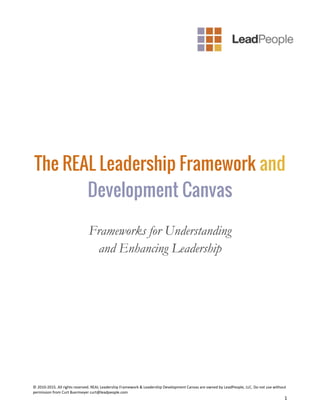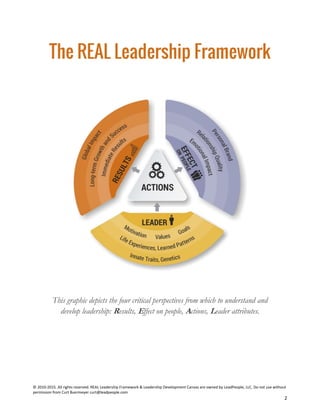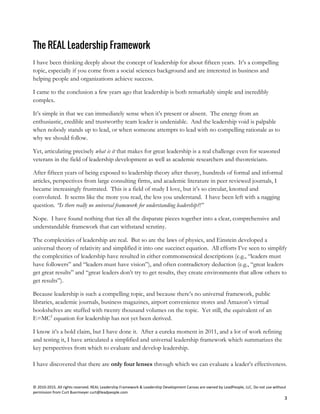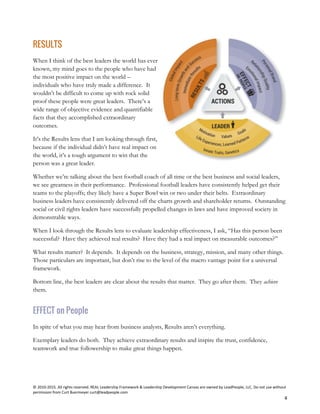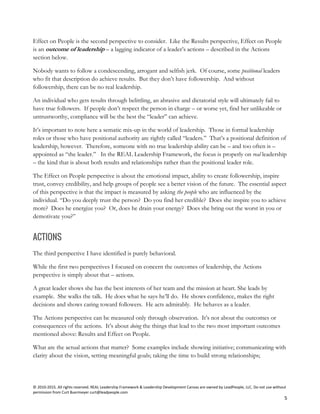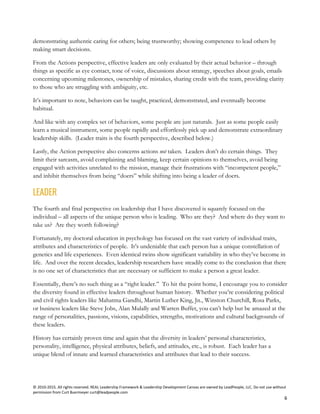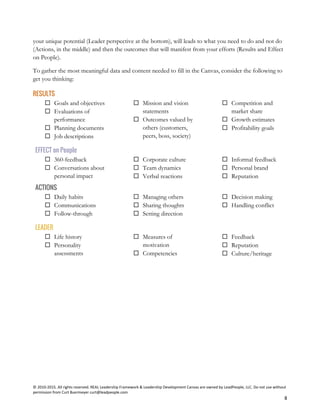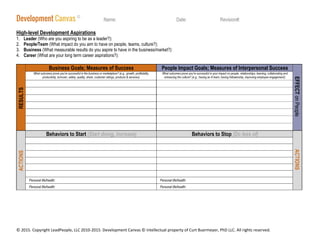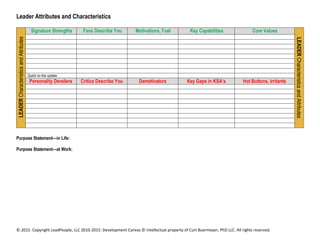The REAL Leadership Framework and Leadership Development Canvas - 101415
- 1. ÂĐ 2010-2015. All rights reserved. REAL Leadership Framework & Leadership Development Canvas are owned by LeadPeople, LLC. Do not use without permission from Curt Buermeyer curt@leadpeople.com 1 The REAL Leadership Framework and Development Canvas Frameworks for Understanding and Enhancing Leadership
- 2. ÂĐ 2010-2015. All rights reserved. REAL Leadership Framework & Leadership Development Canvas are owned by LeadPeople, LLC. Do not use without permission from Curt Buermeyer curt@leadpeople.com 2 The REAL Leadership Framework This graphic depicts the four critical perspectives from which to understand and develop leadership: Results, Effect on people, Actions, Leader attributes.
- 3. ÂĐ 2010-2015. All rights reserved. REAL Leadership Framework & Leadership Development Canvas are owned by LeadPeople, LLC. Do not use without permission from Curt Buermeyer curt@leadpeople.com 3 The REAL Leadership Framework I have been thinking deeply about the concept of leadership for about fifteen years. Itâs a compelling topic, especially if you come from a social sciences background and are interested in business and helping people and organizations achieve success. I came to the conclusion a few years ago that leadership is both remarkably simple and incredibly complex. Itâs simple in that we can immediately sense when itâs present or absent. The energy from an enthusiastic, credible and trustworthy team leader is undeniable. And the leadership void is palpable when nobody stands up to lead, or when someone attempts to lead with no compelling rationale as to why we should follow. Yet, articulating precisely what is it that makes for great leadership is a real challenge even for seasoned veterans in the field of leadership development as well as academic researchers and theoreticians. After fifteen years of being exposed to leadership theory after theory, hundreds of formal and informal articles, perspectives from large consulting firms, and academic literature in peer reviewed journals, I became increasingly frustrated. This is a field of study I love, but itâs so circular, knotted and convoluted. It seems like the more you read, the less you understand. I have been left with a nagging question. âIs there really no universal framework for understanding leadership?!â Nope. I have found nothing that ties all the disparate pieces together into a clear, comprehensive and understandable framework that can withstand scrutiny. The complexities of leadership are real. But so are the laws of physics, and Einstein developed a universal theory of relativity and simplified it into one succinct equation. All efforts Iâve seen to simplify the complexities of leadership have resulted in either commonsensical descriptions (e.g., âleaders must have followersâ and âleaders must have visionâ), and often contradictory deduction (e.g., âgreat leaders get great resultsâ and âgreat leaders donât try to get results, they create environments that allow others to get resultsâ). Because leadership is such a compelling topic, and because thereâs no universal framework, public libraries, academic journals, business magazines, airport convenience stores and Amazonâs virtual bookshelves are stuffed with twenty thousand volumes on the topic. Yet still, the equivalent of an E=MC2 equation for leadership has not yet been derived. I know itâs a bold claim, but I have done it. After a eureka moment in 2011, and a lot of work refining and testing it, I have articulated a simplified and universal leadership framework which summarizes the key perspectives from which to evaluate and develop leadership. I have discovered that there are only four lenses through which we can evaluate a leaderâs effectiveness.
- 4. ÂĐ 2010-2015. All rights reserved. REAL Leadership Framework & Leadership Development Canvas are owned by LeadPeople, LLC. Do not use without permission from Curt Buermeyer curt@leadpeople.com 4 RESULTS When I think of the best leaders the world has ever known, my mind goes to the people who have had the most positive impact on the world â individuals who have truly made a difference. It wouldnât be difficult to come up with rock solid proof these people were great leaders. Thereâs a wide range of objective evidence and quantifiable facts that they accomplished extraordinary outcomes. Itâs the Results lens that I am looking through first, because if the individual didnât have real impact on the world, itâs a tough argument to win that the person was a great leader. Whether weâre talking about the best football coach of all time or the best business and social leaders, we see greatness in their performance. Professional football leaders have consistently helped get their teams to the playoffs; they likely have a Super Bowl win or two under their belts. Extraordinary business leaders have consistently delivered off the charts growth and shareholder returns. Outstanding social or civil rights leaders have successfully propelled changes in laws and have improved society in demonstrable ways. When I look through the Results lens to evaluate leadership effectiveness, I ask, âHas this person been successful? Have they achieved real results? Have they had a real impact on measurable outcomes?â What results matter? It depends. It depends on the business, strategy, mission, and many other things. Those particulars are important, but donât rise to the level of the macro vantage point for a universal framework. Bottom line, the best leaders are clear about the results that matter. They go after them. They achieve them. EFFECT on People In spite of what you may hear from business analysts, Results arenât everything. Exemplary leaders do both. They achieve extraordinary results and inspire the trust, confidence, teamwork and true followership to make great things happen.
- 5. ÂĐ 2010-2015. All rights reserved. REAL Leadership Framework & Leadership Development Canvas are owned by LeadPeople, LLC. Do not use without permission from Curt Buermeyer curt@leadpeople.com 5 Effect on People is the second perspective to consider. Like the Results perspective, Effect on People is an outcome of leadership â a lagging indicator of a leaderâs actions â described in the Actions section below. Nobody wants to follow a condescending, arrogant and selfish jerk. Of course, some positional leaders who fit that description do achieve results. But they donât have followership. And without followership, there can be no real leadership. An individual who gets results through belittling, an abrasive and dictatorial style will ultimately fail to have true followers. If people donât respect the person in charge â or worse yet, find her unlikeable or untrustworthy, compliance will be the best the âleaderâ can achieve. Itâs important to note here a sematic mix-up in the world of leadership. Those in formal leadership roles or those who have positional authority are rightly called âleaders.â Thatâs a positional definition of leadership, however. Therefore, someone with no true leadership ability can be â and too often is â appointed as âthe leader.â In the REAL Leadership Framework, the focus is properly on real leadership â the kind that is about both results and relationships rather than the positional leader role. The Effect on People perspective is about the emotional impact, ability to create followership, inspire trust, convey credibility, and help groups of people see a better vision of the future. The essential aspect of this perspective is that the impact is measured by asking the people who are influenced by the individual. âDo you deeply trust the person? Do you find her credible? Does she inspire you to achieve more? Does he energize you? Or, does he drain your energy? Does she bring out the worst in you or demotivate you?â ACTIONS The third perspective I have identified is purely behavioral. While the first two perspectives I focused on concern the outcomes of leadership, the Actions perspective is simply about that â actions. A great leader shows she has the best interests of her team and the mission at heart. She leads by example. She walks the talk. He does what he says heâll do. He shows confidence, makes the right decisions and shows caring toward followers. He acts admirably. He behaves as a leader. The Actions perspective can be measured only through observation. Itâs not about the outcomes or consequences of the actions. Itâs about doing the things that lead to the two most important outcomes mentioned above: Results and Effect on People. What are the actual actions that matter? Some examples include showing initiative; communicating with clarity about the vision, setting meaningful goals; taking the time to build strong relationships;
- 6. ÂĐ 2010-2015. All rights reserved. REAL Leadership Framework & Leadership Development Canvas are owned by LeadPeople, LLC. Do not use without permission from Curt Buermeyer curt@leadpeople.com 6 demonstrating authentic caring for others; being trustworthy; showing competence to lead others by making smart decisions. From the Actions perspective, effective leaders are only evaluated by their actual behavior â through things as specific as eye contact, tone of voice, discussions about strategy, speeches about goals, emails concerning upcoming milestones, ownership of mistakes, sharing credit with the team, providing clarity to those who are struggling with ambiguity, etc. Itâs important to note, behaviors can be taught, practiced, demonstrated, and eventually become habitual. And like with any complex set of behaviors, some people are just naturals. Just as some people easily learn a musical instrument, some people rapidly and effortlessly pick up and demonstrate extraordinary leadership skills. (Leader traits is the fourth perspective, described below.) Lastly, the Action perspective also concerns actions not taken. Leaders donât do certain things. They limit their sarcasm, avoid complaining and blaming, keep certain opinions to themselves, avoid being engaged with activities unrelated to the mission, manage their frustrations with âincompetent people,â and inhibit themselves from being âdoersâ while shifting into being a leader of doers. LEADER The fourth and final perspective on leadership that I have discovered is squarely focused on the individual â all aspects of the unique person who is leading. Who are they? And where do they want to take us? Are they worth following? Fortunately, my doctoral education in psychology has focused on the vast variety of individual traits, attributes and characteristics of people. Itâs undeniable that each person has a unique constellation of genetics and life experiences. Even identical twins show significant variability in who theyâve become in life. And over the recent decades, leadership researchers have steadily come to the conclusion that there is no one set of characteristics that are necessary or sufficient to make a person a great leader. Essentially, thereâs no such thing as a âright leader.â To hit the point home, I encourage you to consider the diversity found in effective leaders throughout human history. Whether youâre considering political and civil rights leaders like Mahatma Gandhi, Martin Luther King, Jn., Winston Churchill, Rosa Parks, or business leaders like Steve Jobs, Alan Mulally and Warren Buffet, you canât help but be amazed at the range of personalities, passions, visions, capabilities, strengths, motivations and cultural backgrounds of these leaders. History has certainly proven time and again that the diversity in leadersâ personal characteristics, personality, intelligence, physical attributes, beliefs, and attitudes, etc., is robust. Each leader has a unique blend of innate and learned characteristics and attributes that lead to their success.
- 7. ÂĐ 2010-2015. All rights reserved. REAL Leadership Framework & Leadership Development Canvas are owned by LeadPeople, LLC. Do not use without permission from Curt Buermeyer curt@leadpeople.com 7 But there is one exception. I believe there is one leadership attribute found in all extraordinary leaders. Authenticity. The best leaders have just been themselves. I imagine all have put in effort to be better versions of themselves and adjust their style based on their personal growth and understandings of others; yet they have embraced who they are. They have managed their behavior to fit the needs of the situation, to reach their objectives, while not being chameleons. For a positional leader to harness the collective power of people and be a real leader, followers must trust the personâs character. They must have a sense of the true individual, his strengths and flaws. Thus, authenticity is key because followers donât just follow ideas. visions and missions; they follow individuals. If there is not adequate transparency and authenticity, we as prospective followers will find ourselves wondering, âWho is this person Iâm following? Can I trust him? What makes her tick? What does she really want? Where are they headed? Do I really want to follow her to that destination?â Development Canvas To bring out the practical value of the Leadership Framework, I have developed a tool Iâve called the Development Canvas. The Canvas helps you reduce simplify the most valuable developmental targets relevant to your personal and professional development as a leader. I have found through my work with a variety of clients in various industries that, if you take the time to work through each section of the Canvas, you will have a clearer understanding of who you are, what success looks like and how to develop yourself to become the kind of leader you would want to follow. There will be a pathway to success through Results, Effect on People, Actions and your authentic personal attributes as a Leader. Additionally, you will find a high-level aspirations section at the top, where you will articulate simply what kind of leader youâre aspiring to become; what broad effect you want to have on people, teams and culture; what results you want to get for business or more broadly in the world; and what your career aspirations are. At the very bottom of the Canvas, you will articulate your purpose at work, and purpose in life. These statements will be powerful when you truly nail them. When done well, you might even get shivers up your spine. These statements go to the core of your being. What are you on this planet to do? What purpose does your life serve? Unless you are one of the rare people who has already clearly discovered your purpose in life, this section will take lots of time to reflect. On the Canvas, you will also see the four main sections, Results, Effect on People, Actions and Leader characteristics. You will also see important subsections to each, laid out in such a way to reflect how
- 8. ÂĐ 2010-2015. All rights reserved. REAL Leadership Framework & Leadership Development Canvas are owned by LeadPeople, LLC. Do not use without permission from Curt Buermeyer curt@leadpeople.com 8 your unique potential (Leader perspective at the bottom), will leads to what you need to do and not do (Actions, in the middle) and then the outcomes that will manifest from your efforts (Results and Effect on People). To gather the most meaningful data and content needed to fill in the Canvas, consider the following to get you thinking: RESULTS ïĻ Goals and objectives ïĻ Evaluations of performance ïĻ Planning documents ïĻ Job descriptions ïĻ Mission and vision statements ïĻ Outcomes valued by others (customers, peers, boss, society) ïĻ Competition and market share ïĻ Growth estimates ïĻ Profitability goals EFFECT on People ïĻ 360-feedback ïĻ Conversations about personal impact ïĻ Corporate culture ïĻ Team dynamics ïĻ Verbal reactions ïĻ Informal feedback ïĻ Personal brand ïĻ Reputation ACTIONS ïĻ Daily habits ïĻ Communications ïĻ Follow-through ïĻ Managing others ïĻ Sharing thoughts ïĻ Setting direction ïĻ Decision making ïĻ Handling conflict LEADER ïĻ Life history ïĻ Personality assessments ïĻ Measures of motivation ïĻ Competencies ïĻ Feedback ïĻ Reputation ïĻ Culture/heritage
- 9. ÂĐ 2015. Copyright LeadPeople, LLC 2010-2015. Development Canvas ÂĐ intellectual property of Curt Buermeyer, PhD LLC. All rights reserved. Development Canvas ÂĐ Name: Date: Revision#: High-level Development Aspirations 1. Leader (Who are you aspiring to be as a leader?): 2. People/Team (What impact do you aim to have on people, teams, culture?): 3. Business (What measurable results do you aspire to have in the business/market?): 4. Career (What are your long term career aspirations?): RESULTS Business Goals; Measures of Success People Impact Goals; Measures of Interpersonal Success EFFECTonPeople What outcomes prove youâre successful in the business or marketplace? (e.g., growth, profitability, productivity, turnover, safety, quality, share, customer ratings, products & services). What outcomes prove youâre successful in your impact on people, relationships, teaming, collaborating and enhancing the culture? (e.g., having an A team, having followership, improving employee engagement). ACTIONS Behaviors to Start (Start doing, increase) Behaviors to Stop (Do less of) ACTIONS Personal life/health: Personal life/health: Personal life/health: Personal life/health:
- 10. ÂĐ 2015. Copyright LeadPeople, LLC 2010-2015. Development Canvas ÂĐ intellectual property of Curt Buermeyer, PhD LLC. All rights reserved. Leader Attributes and Characteristics LEADERCharacteristicsandAttributes Signature Strengths Fans Describe You Motivations, Fuel Key Capabilities Core Values LEADERCharacteristicsandAttributes Quick on the uptake Personality Derailers Critics Describe You Demotivators Key Gaps in KSAâs Hot Buttons, Irritants Purpose Statementâin Life: Purpose Statementâat Work:

